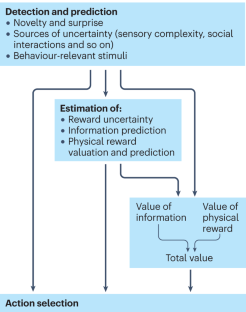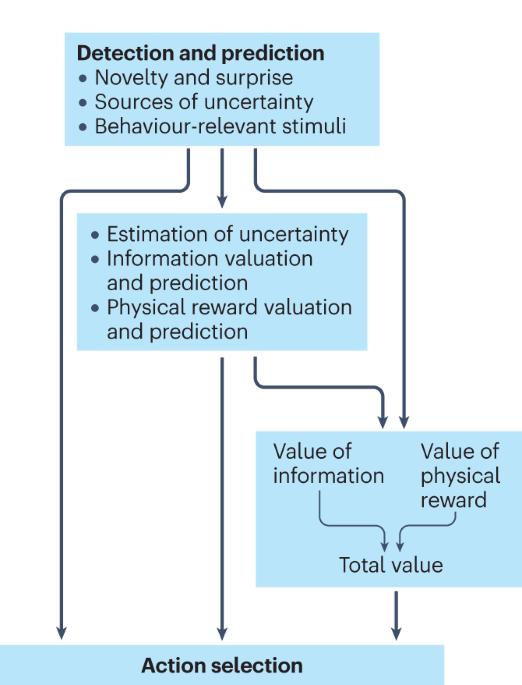Curiosity: primate neural circuits for novelty and information seeking
IF 28.7
1区 医学
Q1 NEUROSCIENCES
引用次数: 0
Abstract
For many years, neuroscientists have investigated the behavioural, computational and neurobiological mechanisms that support value-based decisions, revealing how humans and animals make choices to obtain rewards. However, many decisions are influenced by factors other than the value of physical rewards or second-order reinforcers (such as money). For instance, animals (including humans) frequently explore novel objects that have no intrinsic value solely because they are novel and they exhibit the desire to gain information to reduce their uncertainties about the future, even if this information cannot lead to reward or assist them in accomplishing upcoming tasks. In this Review, I discuss how circuits in the primate brain responsible for detecting, predicting and assessing novelty and uncertainty regulate behaviour and give rise to these behavioural components of curiosity. I also briefly discuss how curiosity-related behaviours arise during postnatal development and point out some important reasons for the persistence of curiosity across generations. Animals frequently engage in curiosity-related behaviours that appear to provide them with no immediate benefits. Monosov discusses the neural circuits in the primate brain that are involved in these non-instrumental information-seeking behaviours, focusing on those that mediate the exploration of novel objects and the pursuit of information to reduce future uncertainties.


好奇心:灵长类动物寻求新奇和信息的神经回路。
多年来,神经科学家一直在研究支持价值决策的行为、计算和神经生物学机制,揭示人类和动物如何做出选择以获得奖励。然而,除了物质奖励或二阶强化物(如金钱)的价值之外,许多决策还受到其他因素的影响。例如,动物(包括人类)经常探索没有内在价值的新奇物体,这完全是因为这些物体很新奇,而且它们表现出获取信息的欲望,以减少对未来的不确定性,即使这些信息不能带来奖励或帮助它们完成即将到来的任务。在这篇综述中,我将讨论灵长类动物大脑中负责检测、预测和评估新奇性和不确定性的回路是如何调节行为并产生好奇心的这些行为成分的。我还简要讨论了好奇心相关行为是如何在出生后的发育过程中产生的,并指出了好奇心跨代持续存在的一些重要原因。
本文章由计算机程序翻译,如有差异,请以英文原文为准。
求助全文
约1分钟内获得全文
求助全文
来源期刊

Nature Reviews Neuroscience
NEUROSCIENCES-
自引率
0.60%
发文量
104
期刊介绍:
Nature Reviews Neuroscience is a multidisciplinary journal that covers various fields within neuroscience, aiming to offer a comprehensive understanding of the structure and function of the central nervous system. Advances in molecular, developmental, and cognitive neuroscience, facilitated by powerful experimental techniques and theoretical approaches, have made enduring neurobiological questions more accessible. Nature Reviews Neuroscience serves as a reliable and accessible resource, addressing the breadth and depth of modern neuroscience. It acts as an authoritative and engaging reference for scientists interested in all aspects of neuroscience.
 求助内容:
求助内容: 应助结果提醒方式:
应助结果提醒方式:


